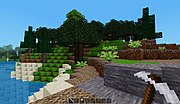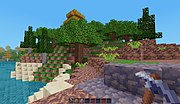software.wikisort.org - Video_game
Minetest is a free and open-source sandbox video game and game creation system with focus on voxel graphics. It is written primarily in C++ and makes use of the Irrlicht Engine. Minetest provides an API for users to write their own games and mods written in Lua. It is cross-platform, being available for Linux-based systems, FreeBSD, Microsoft Windows, MacOS, and Android.
 | |
| Original author(s) | Perttu Ahola |
|---|---|
| Developer(s) | Minetest team |
| Initial release | 0.0.1 / November 2, 2010 |
| Stable release | |
| Repository | github |
| Written in | C++, Lua |
| Engine | Irrlicht |
| Platform | Linux, FreeBSD, Microsoft Windows, MacOS, Android |
| Type | Sandbox, survival |
| License | 2013: LGPL-2.1-or-later[2][3] 2010: GPL-2.0-or-later[4][5] Original: Proprietary[6] |
| Website | https://www.minetest.net/ |
In the default game of Minetest, Minetest Game (MTG for short), players explore a blocky, procedurally-generated 3D world spanning approximately 31 000 full nodes (blocks) in each direction, and may discover and extract raw materials, craft tools and items, and build structures and landscapes. Depending on the game selected and mods present, players can fight computer-controlled "mobs", as well as cooperate with or compete against other players in the same world.
The game mechanics of Minetest are similar to those of the 2009 game Minecraft,[7] though the original author stopped just short of describing it as a "Minecraft clone". Over a decade of active development Minetest has garnered critical acclaim and gained in popularity; since November 2013 Minetest has been downloaded over 1.4 million times from GitHub, and the Android version of Minetest has over 500 thousand downloads on the Google Play store.
Gameplay
This section needs additional citations for verification. (August 2022) |

Minetest is a voxel sandbox video game. Gameplay is in the first-person perspective by default, but players have the option for third-person perspective. The game world is composed of voxels: 3D objects, many of them simple cubes, commonly called "nodes". Different voxels represent various materials, such as dirt, stone, ores, tree trunks, water, and lava. The core gameplay revolves around picking up and placing these objects, one node at a time. Nodes are arranged in a 3D grid, while players can move smoothly around the world. Players can "mine" (or "dig") blocks and then "place" (or "build") them elsewhere, enabling them to modify the game world. Players can also craft a wide variety of hand-held tools to aid them with the world modification. Pick axes allow to dig rocky nodes, shovels speed up the digging of dirt and sand, water buckets allow to pick up water nodes, etc. A player controls a 3D character known as Sam, which is a recursive acronym for "Sam ain't Minecraft".

As players explore the world, new areas are procedurally generated, using a map seed specified by the player. A new game puts the player in the center of a voxel cube 62 thousand nodes across, so the player can travel 31 thousand nodes in any direction (sideways, up, or down)[8] before reaching the invisible wall at the end of the world.
The world is divided into biomes ranging from deserts to jungles to snowfields; the terrain includes plains, mountains, forests, caves, and various lava/water bodies. The in-game time system follows a day and night cycle, and one full cycle lasts 20 real-time minutes.
Minetest provides two basic game mode options: Enable Damage and Creative Mode which affect how players interact with the world and use items. Creative Mode is intended to provide players with infinite resources, while toggling the damage setting determines whether the players are able to take damage from environmental hazards and other players.
Multiplayer

Minetest implements a client-server architecture, and can be played solo or multiplayer. A player starting a new game can choose between playing in a single-player mode, or hosting a server to which other Minetest players can connect.
Customizations

The full source code of Minetest, and all of its artistic assets such as textures and sounds, are distributed under a variety of free licenses, making it easier to create modified versions and derivatives. The base version of Minetest provides an interface for games and mods written in Lua. Games define the basic rules of the game world, and are a core feature of Minetest. Most games feature sandbox gameplay focused on construction, mining, and creativity. Mods are used to further customize various aspects of gameplay, and are an inherent part of Minetest. Mods are server-side and work out of the box when playing on Internet servers, with no manual installation required.
Games
Developers refer to Minetest as an engine rather than a "game" because almost every aspect of gameplay is implemented within so-called games written in Lua. Since version 5.0.0, the main menu of the Minetest engine allows users to browse and install games from a curated list.
Minetest is shipped with two games: Minetest Game, a sandbox, and Development Test implementing a more minimal sandbox primarily for debugging. Minetest Game implements a simple and peaceful game mode with no goals and no built-in computer enemies.
Mods
There are over 1000 free and open-source mods available at Minetest forums. Since version 5.0.0, Minetest features a built-in content picker, allowing users to browse a curated list of add-ons and install mods and texture packs with a single click. Content is also available at Minetest's site ContentDB. Mods can be used to add node types, tools, monsters, player skins, and alter many aspects of the gameplay. Both the forums and the in-game browser exclude non-free or closed source software as a matter of policy.
Development

Minetest was originally released in November 2010 under a proprietary license.[6] Shortly afterwards the license was changed to the GPL-2.0-or-later license.[5] By agreement among major contributors, in June 2012 the project license was to be changed to LGPL-2.1-or-later, though at the time small parts still remained under the GPL-2.0-or-later license.[4] In September 2013, the transition was complete.[3] While LGPL-2.1-or-later remains the main license for the Minetest engine, other free and open-source licenses are used for various other parts of the latest release.[2]
Perttu Ahola was the only developer working on the project for about six months, until Ciaran Gultnieks started making code contributions in May 2011.[9] The roster of contributors grew and changed over the years. As of July 2020, there are 9 active core developers and 15 active contributors. Project participants do not have set roles, but rather keep their activity within their respective areas of expertise. Perttu Ahola's role morphed over the years: whereas initially it was engine development, now it is mostly Web-hosting and administration, assigning core developer, moderator, and other roles to people, as well as being the final word in cases where other developers are unable to render a decision.[9]
Usage in education
Minetest has been used in educational environments to teach subjects such as mathematics, programming, and earth sciences. Such examples are:
- In 2017 in France, Minetest was used to teach calculus and trigonometry.[10]
- At Federal University of Santa Catarina in Brazil, Minetest was used to teach programming in a variant called MineScratch.[11]
- In 2018, for Laboratory Education and Apprenticeships (EDA) at the Paris Descartes University, Minetest was used to teach life and earth sciences to year 6 students who could not observe some phenomena in person but could experience them in the Minetest virtual world.[12]
Reception
Opensource.com listed Minetest at #1 in its "Best open source games of 2015",[13] stating that it is maybe "the most complete alternative to Minecraft", and noted its expansibility, stating that it contains a user-friendly API for creating mods in Lua.[14] PC Magazine listed Minetest among "The best Sandbox Creation Games for Minecraft Fans".[15]
See also
- Free and open source software
- List of open-source video games
- Linux gaming
References
- "5.6.1".
- "LICENSE.txt". GitHub. October 25, 2021.
- "Remove doc/gpl-2.0.txt, add doc/lgpl-2.1.txt". GitHub. September 28, 2013.
- "Switch the license to be LGPLv2/later, with small parts still remaining as GPLv2/later, by agreement of major contributors". GitHub. June 5, 2012.
- "Working version before block send priorization update". GitHub. November 27, 2010.
- "Initial files". GitHub. November 26, 2010.
- Saunders, Mike (November 2017). "Minetest". Linux Magazine (204/2017). Archived from the original on February 3, 2021. Retrieved July 30, 2020.
- "Official website". Retrieved February 28, 2021.
- "Open source game developer Perttu Ahola talks about Minetest with Wikinews". Wikinews. June 30, 2020. Archived from the original on July 12, 2020. Retrieved July 11, 2020.
- Boutet, Henri. (January 2017). "Mathématiques et "serious gaming": l'exemple de Minetest" [Mathematics and "serious gaming": the example of Minetest]. Mathématice (in French) (53). Archived from the original on June 29, 2019. Retrieved October 12, 2019.
- da, Rocha, Jhonata (November 23, 2016). "MineScratch: integração minetest-scratch para apoiar o ensino de programação" [MineScratch: Minetest-Scratch Integration to Support Programming Teaching]. Repositório Institucional da UFSC (in Brazilian Portuguese). Archived from the original on February 3, 2021. Retrieved February 16, 2019.
- Pauty-Combemorel C. (February 7, 2018). "Utilisation d'un jeu vidéo dans le cadre de l'enseignement des SVT: le cas de Minetest. De 0 à 1 ou l'heure de l'informatique à l'école" [Using a video game as part of the teaching of Life and Earth Sciences: the case of Minetest. From 0 to 1 or computer time at school.] (in French). Archived from the original on October 11, 2019. Retrieved October 11, 2019.
- Muilwijk, Robin (December 30, 2015). "Best open source games of 2015". Opensource.com. Archived from the original on May 1, 2019. Retrieved February 16, 2019.
- Baker, Jason (October 12, 2017). "10 open source alternatives to Minecraft". Opensource.com. Archived from the original on October 30, 2019. Retrieved October 12, 2019.
- Cohen, Jason (August 28, 2019). "The Best Sandbox Creation Games for Minecraft Fans". Archived from the original on December 17, 2019. Retrieved December 17, 2019.
{{cite journal}}: Cite journal requires|journal=(help)
На других языках
- [en] Minetest
[ru] Minetest
Minetest (изначально Minetest-c55 ) — игра-песочница с открытым исходным кодом, созданная по мотивам Infiniminer и Minecraft, написанная на языке C++ и включающая интерпретатор Lua. Игру создал в 2010 году Пертту Ахола, известный как "celeron55", и с тех пор её развивает сообщество.Другой контент может иметь иную лицензию. Перед использованием материалов сайта WikiSort.org внимательно изучите правила лицензирования конкретных элементов наполнения сайта.
WikiSort.org - проект по пересортировке и дополнению контента Википедии





